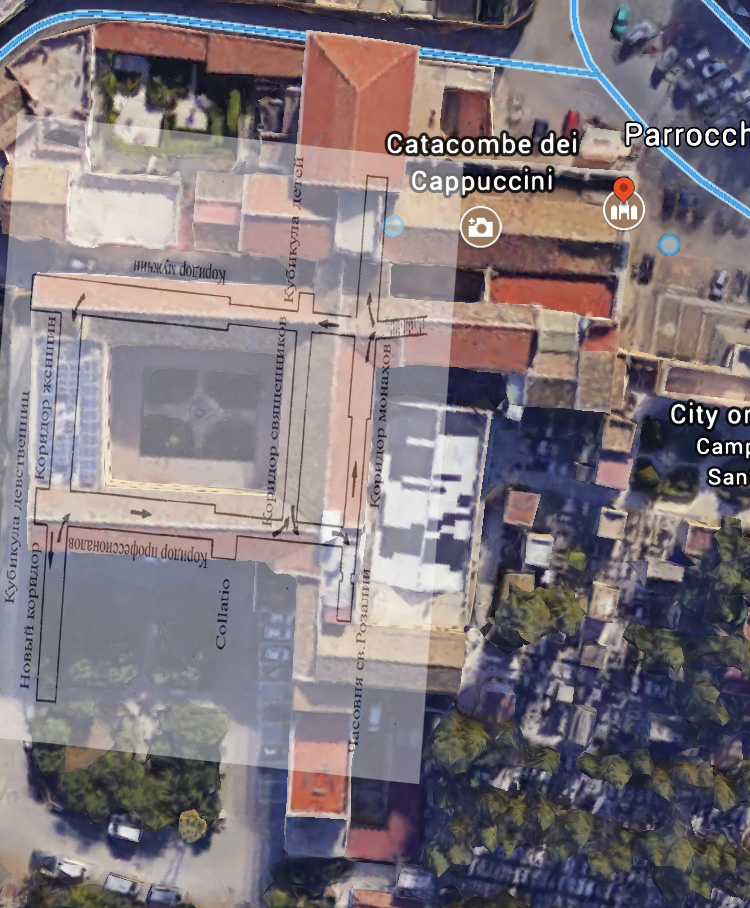 |
| Capuchin Catacombs of Polermo overlaid. |
Do you do much research before you write?
I sure do. During and after, as well. But none more than I am doing for the book I am currently writing. It is the fifth book in the Students of Jump series, and it takes place largely in the Capuchin Catacombs of Polermo, Italy.
What makes it so much more involved than other research I have done is that the site does not allow photographs, video and the descriptions are limited to tourists’ who talk mostly about how ghoulishly fun it was.
My questions are rarely answered by these very brief comments or the pictures the tourists snuck out. The research footage taken by those allowed to film is often better and occasionally there will be one picture that will after I have looked at hundreds finally supply the bit I needed.
One example is the floor of the crypt. I could tell the slabs of stone were engraved, but I could only guess what was engraved. And finally an entire year from the time I started my research (just a few days ago actually) I found someone with the presence of mind to photograph the floor. I had my answer about what was engraved in the polished stone. Names and dates of death.
Until today, I didn’t know if that meant these people were buried beneath the stone or if the names are of the people mounted in the niches cut into the walls. I received my answer in a thesis paper written by Mary Buckland Rutin in 2013 for her honors program at the University of South Florida, St. Petersburg. Thank you, Mary. The names listed and their dates of death signify the people buried below.
One of the far more challenging questions I have answered came from gathering an accurate sense of the site as well as the buildings beside and above it. I know that the catacombs were excavated beneath the convent and the church and even a small portion of the cemetery, but how it lays beneath these buildings has taken some research on my part. So what did I do?
- I located a map of the catacombs themselves, which just to add a little fun to my work was labeled in a language I did not recognize. It made me think of Russian. Google translate to the rescue. This first step was essential if I wanted my character to move about these catacombs, and I needed to be able to place her accurately in the halls among the different classes of mummified individuals. Each corridor is designated for a particular group of people: monks, priests, professionals, women, men and even virgins and children.
- So now I had a translated map. I searched for more tourists shots of the buildings and used Google Earth to help me understand how they sat in relation to each other. Also, I needed to know where they were located in terms of the exterior entrance to the catacombs.
- I also used pictures taken by numerous individuals to garner different views of the same bit of descending access to the catacombs. I learned there are three flights of stairs that run straight down into the monks’ hall below. But above the first flight is a sharp turn that leads down from the public entrance. The tunnel has a smooth curved ceiling and tiled floor that descends to that sharp turn. This was very important evidence as you will find in my next search for information. But again thanks to Mary Rutin mentioned above, I have learned this is not the original entrance. The earlier access was damaged from bombing. There was fire damage as well which explains the wide difference in number of cadavers in the catacomb, from 2000 up to 8000. The numbers are accurate depending upon when the census was taken, before or after World War II.
- Though I know that the catacombs were excavated beneath the church and convent, I do not know from any description or pictures how they lay beneath the ground in relation to those buildings. Hence more pictures needed to be examined.
- Imagine how many pictures I looked at not giving a shred of value to the people smirking and pointing about. I was interested in what was behind them, in the shadows or overhead.
- Several of the catacomb halls show that there are windows. So the upper portion of the tall corridors of the dead are above ground. Hmm.
- The tunnels were excavated in very straight lines, and the shape is rectangular with overruns at three of the four corners.
- The convent is rectangular.
- The entrance to the catacombs is located in front of the extreme right of the convent (if you are standing looking at the convent).
- Remember that sharp turn? I located a picture (two actually) that show the open outside entrance to the room one must enter to access the tunnel. There is a painting or mosaic just discernible through the door. And some kind soul took a picture of that painting, which is standing to the immediate left of the entrance to the descending tunnel. There is even a sign pointing the way. So I know that the tunnel heads off to the right parallel with the convent entrance.
- Google Earth gives sharp images overhead.
- Photoshop can be used to reduce the opacity of a picture. I snapped a picture of the bird’s eye view of the convent, church and cemetery, and placed them in Photoshop. Then I took my copy of the outline of the catacombs and reduced its opacity. Then I overlaid my transparent outline and turned, reduced and otherwise manipulated it until the tunnel entrance was lined up with the stairs marked on the outline. What do you know? The lines fit right within the frame of the convent, the overruns lining up properly as well.
- My current mystery is figuring out how the convent is laid out inside and if there is an entrance connecting it with the church it shares a wall with. I have found pictures of the church, so I’ll be able to write a reasonable description when my character passes through it, but I’ve yet to find any information on the interior of the convent. I may have to see if there are other convents of the same vintage in Italy that provide some view of the interior and extrapolate a likely interior. One satisfying point is if I can’t find an accurate description, there will be few who can dispute my version. Hmm. Do monks read science fiction? At least one, I imagine. There’s always an odd bird in the bunch.
So do I research? Indeed I do. Better get to it.
